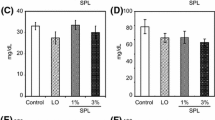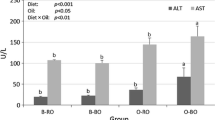Abstract
Lipase-catalyzed interesterification was used to prepare different structured lipids (SL) from rice bran oil (RBO) by replacing some of the fatty acids with α-linolenic acid (ALA) from linseed oil (LSO) and n-3 long chain polyunsaturated fatty acids (PUFA) from cod liver oil (CLO). In one SL, the ALA content was 20% whereas in another the long chain n-3 PUFA content was 10%. Most of the n-3 PUFA were incorporated into the sn-1 and sn-3 positions of triacylglycerol. The influence of SL with RBO rich in ALA and EPA + DHA was studied on various lipid parameters in experimental animals. Rats fed RBO showed a decrease in total serum cholesterol by 10% when compared to groundnut oil (GNO). Similarly structured lipids with CLO and LSO significantly decreased total serum cholesterol by 19 and 22% respectively compared to rice bran oil. The serum TAGs level of rats fed SLs and blended oils were also significantly decreased by 14 and 17% respectively compared to RBO. Feeding of an n-3 PUFA rich diet resulted in the accumulation of long chain n-3 PUFA in various tissues and a reduction in the long chain n-6 PUFA. These studies indicate that the incorporation of ALA and EPA + DHA into RBO can offer health benefits.
Similar content being viewed by others
References
Simopoulos AP (1999) Essential fatty acids in health and chronic diseases. Am J Clin Nutr 70:S560–S569
Simopoulos AP (2001) n-3 Fatty acids and human health: defining strategies for public policy. Lipids 36:S83–S89
Schultz MB, Hoffmann K (2006) Methodological approaches to study dietary pattern in relation to risk factors of CHD and stroke. Br J Nutr 95:860–869
Katan MB, Zock PL, Mensink RP (1995) Dietary oils, serum lipoproteins, and coronary heart disease. Am J Clin Nutr 61:1368S–1373S
Morris MC (1994) Dietary fats and blood pressure. J Cardiovasc Risk 1:21–30
Sacks FM, Hebert P, Appel LJ, Borhani NO, Applegate WB, Cohen JD, Cutler JA, Kirchner KA, Kuller LH, Roth KJ (1994) The effect of fish oil on blood pressure and high-density lipoprotein-cholesterol levels in phase I of the Trials of Hypertension Prevention. Trials of hypertension prevention collaborative research group. J Hyperten 12:S23–S31
Ghafoorunissa (1990) Availability of linoleic acid from cereal: pulse diets. Lipids 25:763–766
Ghafoorunissa (1996) Fats in Indian diets and their nutritional implications. Lipids 31:S287–S291
Achaya KT (1995) Fat intake in India: an update. J Sci Ind Res 54:91–97
COMA (1994) Cardiovascular review group. Report on health and social subjects: nutritional aspects of cardiovascular disease. London: Department of health. 46
Domingo JL (2007) Omega-3 fatty acids and the benefits of fish consumption: is all that glitters gold? Environ Int 33:993–998
Green AG, Marshall DR (1984) Isolation of induced mutants in linseed (Linum usitatissimum) having reduced linolenic acid content. Euphytica 33:321–328
Lauren WC, Robert EC, Eric JM, Jolly CA (2005) Dietary n-3 polyunsaturated fatty acids increase T-lymphocyte phospholipids mass and acyl-CoA binding protein expression. Lipids 40:81–87
Shin T, Godber JS, Martin DF, Wells JH (1997) Hydrolytic stability and changes in E-vitamers and oryzanol of extruded rice bran during storage. J Food Sci 62:704–708
Seetharamaiah GS, Chandrasekhara N (1989) Studies on hypocholesterolemic activity of rice bran oil. Atherosclerosis 78:219–235
Sugano M, Tsuji E (1997) Rice bran oil and cholesterol metabolism. J Nutr 127:521S–524S
Wilson TA, Nicolosia JR, Woolfreya B, Kritchevsky D (2007) Rice bran oil and oryzanol reduce plasma lipid and lipoprotein cholesterol concentrations and aortic cholesterol ester accumulation to a greater extent than ferulic acid in hypercholesterolemic hamsters. J Nutr Biochem 18:105–112
Rukmini C, Raghuram TC (1991) Nutritional and biochemical aspects of the hypolipidemic action of rice bran oil. J Am Coll Nutr 10:593–601
FAO and WHO joint consultation (1995) Fats and oils in human nutrition. Nutr Rev 53:202–205
Simopolous AP, Leaf A, Salem N (1999) Workshop on the essentiality of recommended dietary intakes for omega 6 and omega 3 fatty acids. National Institute of Health, Bethesda
Barelo- Coblijin G, Collison LW, Jolly CA, Murphy EJ (2005) Dietary α- linolenic acid increase brain but not heart and liver docosahexaenoic acid levels. Lipids 40:787–798
Cughey GE, Mantzioris E, Gibson RA, Cleland LG, James MJ (1996) The effect of human tumor necrosis factor alpha and interleukin 1 beta production of diet enriched in n-3 fatty acid from vegetable oil or fish oil. Am J Clin Nutr 63:116–122
Cunnane SC, Ganguly S, Menaard C, Liede AC, Hamadeh MJ, Chen ZY, Woolever T (1993) High α- linolenic acid flax seed (Linum usitatissimum). Some nutritional properties in humans. Br J Nutr 69:443–453
Jenkins DJA, Kendall CWC, Vidgen E, Agarawal S, Rao AV, Rosenberg RS, Diamandis EP, Novokmet R, Mehling CC, Perera T (1999) Health aspects of partially defatted flaxseed, including effect on serum lipids, oxidative measures and ex vivo androgen and progestin activity: a controlled crossover trial. Am J Clin Nutr 69:395–402
Owen AJ, Peter-Przyborowska BA, Hoy AJ, McLennan PL (2004) Dietary fish oil dose—and time—response effects on cardiac phospholipids fatty acid composition. Lipids 39:955–961
Tso P, Karlstad MD, Bistrian BR, DeMichele SJ (1995) Intestinal digestion, absorption and transport of structured triglycerides and cholesterol in rats. Am J Physiol 268:G568–G577
Jensen GL, McGarvey N, Tarasezewski R, Wixon SK, Seidner DL, Pai T, Yeh YY, Lee TW, DeMichele SJ (1994) Lymphatic absorption of enterally fed structured triacylglycerol vs physical mix in a canine model. Am J Clin Nutr 60:518–524
Ikeda I, Tomari Y, Sugano M, Watanabe S, Nagata J (1991) Lymphatic absorption of structured glycerolipids containing medium-chain fatty acids and 18:2 acid and their effects on cholesterol absorption in rats. Lipids 26:369–373
Lee KT, Akoh CC (1999) Effects of structured lipid containing omega-3 and medium chain fatty acids on serum lipids and immunological variables in mice. J Food Biochem 23:197–208
Luddy FE, Barford RA, Herb SF, Magidman P, Riemenschneider RW (1964) Pancreatic lipolysis of triglycerides by a semimicro technique. J Am Oil Chem Soc 41:693–696
Morrison MR, Smith M (1964) Preparation of fatty acid methyl esters and dimethyl acetyls from lipids with boron fluoride-methanol. J Lipid Res 5:600–608
Anonymous (1977) Report of the American institute of nutrition, Ad-hoc committee on standards for nutritional studies. J Nutr 107:1340–1348
Folch J, Lees M, Sloane-Stanley GH (1957) A simple method for the isolation and purification of total lipids from animal tissues. J Biol Chem 226:497–509
Yagi K (1984) Lipid peroxidation: assay for blood plasma or serum. Meth Enzymol 105:238–331
Berg JA, Aust SD (1978) Microsomal lipid peroxidation. Meth Enzymol 52:302–310
Searcy RL, Bergquist LM (1960) A new color reaction for the quantification of serum cholesterol. Clin Chim Acta 5:192–199
Warnick GR, Albers JJ (1978) A comprehensive evaluation of the heparin manganese chloride precipitation procedure for estimating HDL cholesterol. J Lipid Res 19:65–76
Stewart JCM (1980) Colorimetric evaluation of phospholipids with ammonium ferrothiocyanate. Anal Biochem 104:10–14
Fletcher MJ (1968) A colorimetric method for estimating serum triglycerides. Clin Chim Acta 22:303–307
Snedecor GW, Cochran WG (eds) Statistical methods. Iowa state University Press, Ames
Macrae AR (1983) Lipase-catalyzed interesterification of oils and fats. J Am Oil Chem Soc 60:291–294
Xu X, Fomuso LB, Akoh CC (2000) Modification of Menhaden oil by enzymatic acidolysis to produce structured lipids: optimization by response surface design in a packed bed reactor. J Am Oil Chem Soc 77:171–176
Xu X, Skands ARH, Alder-Nissen J, Hoy C-E (1998) Production of specific structured lipids by enzymatic interesterification: optimization of the reaction by response surface design. Fett/Lipids 100:463–471
DeMichele SJ, Karlstad MD, Babayan BK, Istfan N, Blackburn GL, Bistrian BR (1988) Enhanced skeleton muscle and liver protein synthesis with structured lipids in enterally fed burned rats. Metabolism 37:787–795
Mok KT, Maiz A, Yamazaki K, Sobrado J, Babayan BK, Moldawer LL, Bistrian BR, Blackburn GL (1984) Structured medium-chain and long-chain triglyceride emulsions are superior to physical mixture in sparing body protein in the burned rats. Metabolism 33:910–915
Gerster H (1998) Can adult adequately convert α-linolenic acid (18:3n-3) to eicosapentaenoic acid (20:5n-3) and docosahexaenoic acid (22:6n-3). Intl J Vit Nutr Res 68:159–173
Mantzioris E, James MJ, Gibson RA, Cleland LG (1994) Dietary substitution with α-linolenic acid—rich vegetable oil increase eicosapentaenoic acid concentration in tissues. Am J Clin Nutr 59:1304–1309
Bazinet RP, McMillan EG, Cunnane SC (2003) Dietary α-linolenic acid increase the n-3 PUFA content of Sow’s milk and tissues of suckling piglets. Lipids 38:1045–1049
Ramaprasad TR, Baskaran V, Sambaiah K, Lokesh BR (2004) Supplementation and delivery of n-3 fatty acids through spray—dried milk reduces serum and liver lipids in rats. Lipids 39:627–632
Barcelo-Coblijin G, Collison LW, Jolly CA, Murphy EJ (2005) Dietary α-linolenic acid increases brain but not heart and liver docosahexaenoic acid levels. Lipids 40:787–797
MacDonald- Wicks LK, Garg ML (2004) Incorporation of n-3 fatty acids into plasma and liver lipids into rats: importance of background dietary fat. Lipids 39:545–551
Medeiros DM, Hampton M, Kurtzer K, Parelman M, Al- Tamimi E, Drouillard JS (2007) Feeding enriched omega-3 fatty acid beef to rats increases omega-3 fatty acid content of heart and liver membranes and decrease serum vascular cell adhesion molecule-I and cholesterol levels. Nutr Res 27:295–299
Brenner RR (1984) Effect unsaturated fatty acids on membrane structure and kinetics. Prog Lipid Res 23:69–96
Ahmed A, Moriguchi T, Salem NJ (2002) Decrease in neuron size in docosahexaenoic acid-deficient brain. Pediatr Neurol 26:210–218
Kotani S, Sakaguchi E, Warashina S, Matsukawa N, Ishikura Y, Kiso Y, Sakakibara M, Yoshimoto T, Guo J, Yamashima T (2006) Dietary supplementation of arachidonic and docosahexaenoic acids improves cognitive dysfunction. Neurosci Res 56:159–164
Kao BT, DePeters EJ, Enennaam LV (2006) Mice raised on milk transgenically enriched with n-3 PUFA have increased brain docosahexaenoic acid. Lipids 41:543–549
Zhong F, Sinclair AJ (2000) Increased α-linolenic acid intake increase tissue α-linolenic acid content and apparent oxidation with little effect on tissue docosahexaenoic acid in the guinea pigs. Lipids 35:395–400
Wistuba TJ, Kegely EB, Apple JK, Rule DC (2007) Feeding feedlot steers fish oil alters the fatty acid composition of adipose and muscle tissue. Meat Sci 77:196–203
Lin DS, Connors WE (1990) Are the n-3 fatty acids from dieatary fish oil deposited in the triglyceride stores of adipose tissue? Am J Clin Nutr 51:535–539
Kris-Etherton PM, Harris WS, Appel LJ (2002) Fish consumption, fish oil, omega-3 fatty acids, and cardiovascular disease. Circulation 106:2747–2757
Acknowledgments
The authors thank the Director, CFTRI Mysore, for constant encouragement. Rajni Chopra expresses her gratitude and thanks to the University Grant Commission (UGC), New Delhi for awarding her a Senior Research Fellowship.
Author information
Authors and Affiliations
Corresponding author
About this article
Cite this article
Chopra, R., Sambaiah, K. Effects of Rice Bran Oil Enriched with n-3 PUFA on Liver and Serum Lipids in Rats. Lipids 44, 37–46 (2009). https://doi.org/10.1007/s11745-008-3240-z
Received:
Accepted:
Published:
Issue Date:
DOI: https://doi.org/10.1007/s11745-008-3240-z




